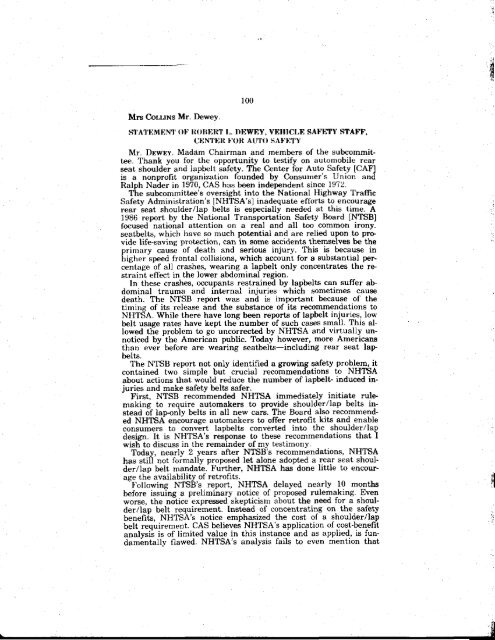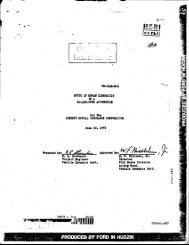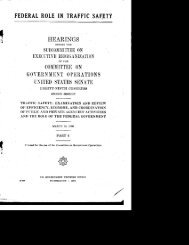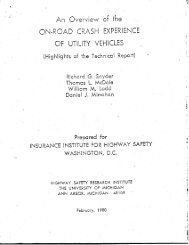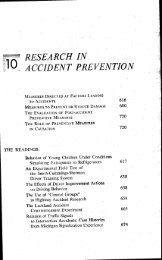virsight hearing - Motor Vehicle Hazard Archive Project
virsight hearing - Motor Vehicle Hazard Archive Project
virsight hearing - Motor Vehicle Hazard Archive Project
Create successful ePaper yourself
Turn your PDF publications into a flip-book with our unique Google optimized e-Paper software.
Mrr Cou-rNs Mr. Dewey.<br />
100<br />
sTA'l'HMENT Ol'IrOltH,RT 1,. t)EWEY, Vl: tCt,E SAI.'ETY STAI'F,<br />
cDNTt.)rr ]'oR AtiTo SA]'ETY<br />
Mr. Drwty- Madam Chairman and members of the subcommittee.<br />
Thank you for the opportunity to testify on automobile rear<br />
seat shoulder and lapbelt safety. The C;enter for Auto Safety [CAF]<br />
is a nonprofit organization founded by C,onsumer's Union and<br />
Ralph Nader in l9?0, CAS hus been independent since 1972.<br />
The subcommittee's oversight into the National Highway Traffic<br />
Safety Administration's INHTSA's] inadequate efforts to encourage<br />
rear seat shoulder/lap belts is especially needed at this time. A<br />
1986 report by the National Transportation Safety Board INTSB]<br />
focused national attention on a real and all too common irony.<br />
seatbelts, which have so much potential and are relied upon to pro<br />
vide life-saving protection, can in some accidents themselves be the<br />
primary cause of death and serious injury. This is because in<br />
higher speed frontal collisions, which account for a substantial percentage<br />
of all crashes, wearing a lapbelt only concentrates the re<br />
straint effect in the lower abdominal region.<br />
In these crashes, occupants restrained by lapbelts can suffer abdominal<br />
trauma and internal injuries which sometimes cause<br />
death. The NTSB report was and is important because of the<br />
timing of its release and the substance of its recommendations to<br />
NHTSA. While there have long been reports of lapbelt injuries, low<br />
belt usage rates have kept the number of such cases small. This allowed<br />
the problem to go uncorrected by NHTSA and virtually unnoticed<br />
by the American public. Today however, more Americans<br />
than evei before are wearing seatbelts-including rear seat lap<br />
belts.<br />
The NTSB report not only identified a growing safety problem, it<br />
contained two 'simple buf crucial recoirmendlations tb NH'ISA<br />
about actions that would reduce the number of lapbelt- induced in-<br />
- iuries and make safetv belts safer.<br />
First, NTSB recommended NHTSA immediately initiate rulemakine<br />
to require automakers to provide shoulder/lap belts instead<br />
oJ lap-only belts in all new cars. The Board also recommended<br />
NHTSA encourage automakers to offer retrofit kits and enable<br />
consumers to convert lapbelts converted into the shoulder/lap<br />
desien. lt is NHTSA's response to these recommendations that I<br />
wisli to discuss jn the remainder of my testimony.<br />
Todav. nearlv 2 vears after NTSB's recommendations, NHTSA<br />
has stifi not foimaliy proposed let alone adopted a rear seat shoulder/lap<br />
belt mandate. Further, NHTSA has done little to encouraee<br />
-Followine t hi availabilitv of retrofits.<br />
NTSB's report, NHTSA delayed nearly 10 months<br />
before issuing.a prelimiirary<br />
.notice of proposed rulemaking Even<br />
worse. the notice ex pressed skepticism about the need for a shoulder/lap<br />
belt requirement. lnst{iad of concentrating on the safety<br />
benefiis, NHTSA's notice emphasized the cost of a shoulder/lap<br />
belt requirement. CAS believes NHTSA's application of cost-benef-rt<br />
analysii is of limited value in this instance and as applied, is fun'<br />
damlntally flawed. NHTSA's analysis fails to even mention that<br />
i !"<br />
{


